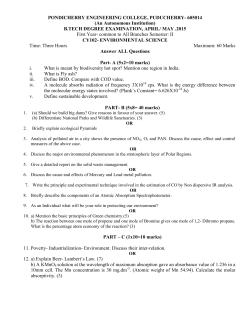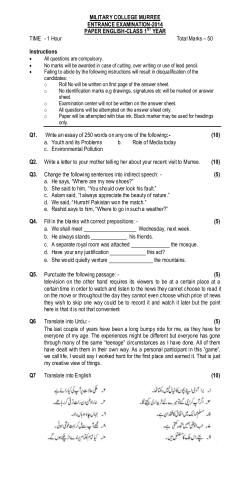
Examination past question for : BCH 208 2012
REDEEMER’S UNIVERSITY km 46/48 Lagos-Ibadan Expressway, Redemption City, Ogun State COLLEGE OF NATURAL SCIENCES DEPARTMENT OF CHEMICAL SCIENCES B. Sc. BIOCHEMISTRY DEGREE BCH 208: TECHNIQUES IN BIOCHEMISTRY SECOND SEMESTER EXAMINATION 2010/2011 SESSION UNITS: 3 Instructions: Attempt any FIVE questions Time Allowed: 2 hours 30 minutes 1. (a) Differentiate between normal phase and reverse phase high pressure liquid chromatography (HPLC). (b) [4 marks] Write briefly on rate zonal and isopycinic centrifugation highlighting their differences and applications. [6 marks] (c) What do you understand by the terms chemical shift and ‘spin-spin’ coupling? (d) Mentions commonly used detectors in gas chromatography and enumerate their [2 marks] merits over one another. (e) [6marks] Briefly explain why a protein existing in different phosphorylated forms would separate as single band in an SDS-added gel and more than one band in isoelectric focusing gel? 2. (a) [2 marks] Give a detail account of how you would use radioimmunoassay (RIA)technique to quantify a named hormone in human body fluid. Explain the working principle of this technique. (b) 3. [10marks] Explain what you understand by peak enhancement or spiking and retention time in gas chromatography data analysis? [4 marks] (c) Justify the relevance of Beer-Lambert’s law to spectrophotometry. [4 marks] (d) What is general elution problem and how can this be addressed? [2 marks] (a) In a separation by cation-exchange chromatography , predict the order of elution (first-last) for each of the following sets of amino acids at pH =4. (i) Gln, Asp, HiS (b) (ii) Arg, Gln, Ala [3 marks] How does temperature affect the resolving ability of the column in a chromatographic system? (d) [3 marks] Describe the various detection methods used in HPLC highlighting types of biomolecules detected by them (c) (iii) Phe, HiS, Gln [3 marks] Draw a slab gel to show the results of non-denaturing electrophoresis of the following mixture of proteins: The molecular weights for each are given thus: Lysozyme (13,390); egg white albumin (45,000); chymotrypsin (21,600), serum albumin(65,400) [2 marks each]. (e) Explain the purpose of each of the following chemical reagents used in PAGE. (i) (iii) 4. (a) Acrylamide (ii) I N,N -methyllene-bis-acrylamide (iv) I Sodium dodecyl sulphate (SDS) Coomasie blue dye I (v) N,N,N , N –tetramethylethylene diamine(TEMED) (vi) Bromophenol blue [6 marks] Describe the toxic characteristics of acrylamide and ethidium bromide and outline precautions necessary for its use (b) [4 marks] The dye ethidium bromide is often used to detect the presence of nucleic acids on electrophoresis supports. Explain how it functions as an indicator (c) [2 marks] Each of the proteins listed below is treated with sodium dodecyl sulphate (SDS) and separated by electrophoresis on a polyacrylamide slab gel. Draw pictures of the final results. (i) Myoglobin (ii) Hemoglobin [4 marks] (Two alpha submits, molecular weight = 15,500; two beta submits, molecular weight = 16,000). (d) Describe in concise terms how you would design a centrifuge experiment to isolate sediments containing cell nuclei. (e) Define the following terms as relate to chromatography (i) Development (f) [2 marks] (ii) Effluent (iii) Partition coefficient, KD [3 marks] Assume that you have centrifuged in a density gradient a sample of DNA that contained closed, circular and super-coiled DNA. Would you expect to see two bands in the sedimentation pattern? Explain (g) What are the advantages and limitations of gas chromatography? Explain how the limitations can be addressed. 5. (a) [1 mark] [4 marks] (i) Give a concise description of how you would fractionate a named rat tissue. [10marks] (ii) Explain the working principle of the biochemical technique involved in (i) above. [2 marks] (b) (i) Describe briefly how you would identify a mixture of amino acids using either paper or thin layer chromatography (ii) Why is it advisable not to handle the paper used in paper chromatography with bare hands? 6. [6 marks] (a) How does a gas chromatography work? What are the merits and demerits? [2 marks] [12marks] (b) Mention and explain factors which could influence separation using a gas chromatograph [8 marks] 7. (a) Write short notes on the following: (i) High Pressure Liquid Chromatography [3 marks] (ii) Ion-Exchange chromatography [3 marks] (b) (iii) Mass spectrometry [3 marks] (iv) Isoelectric focusing [3 marks] (v) Fluorescence spectrometry [3 marks] (vi) Nuclear magnetic resonance [3 marks] An enzyme has a sedimentation coefficient of 3.5S.When a substrate molecule is bound into the active site of the enzyme, the sedimentation coefficient decreases to 3.0S. Explain this change [2 marks]
© Copyright 2025









